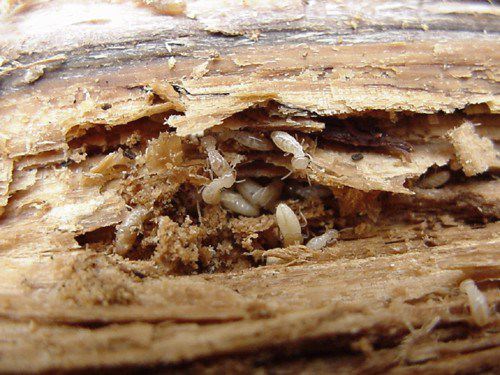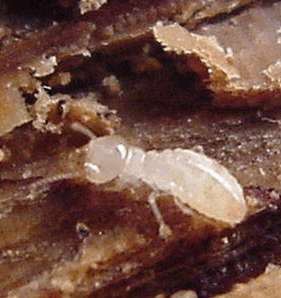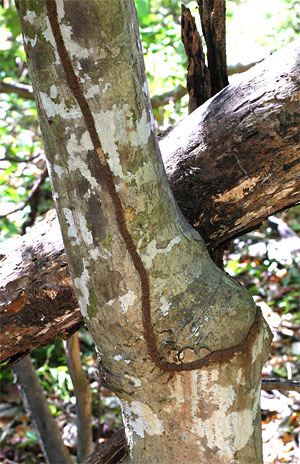|
|
|||
|
(Back to Preceding Week; on to Next Week) |
|
A SWARM OF . . . TERMITEROACHES?
One warm and sunny afternoon last week--13 April to be exact--we were strolling back from our roadside mailbox when a slow-moving insect with white wings flitted past. Soon there was another--then several more coming from the same direction--so we followed the swarm back into the yard at Hilton Pond Center. Near the front porch of our old farmhouse was a one-gallon black plastic flower pot filled with dark earth and a few unidentified seedlings. The plants and soil were literally covered by scores of these half-inch winged critters, crawling about with no discernible goal and taking off a few at a time. We ran into the farmhouse to get a camera, macro lens, and tripod, taking about two minutes to gather our equipment and return to the yard. In that brief period the hundreds of insects had become just a dozen or so, giving us little time to snap some quick photos before the last of them took wing.
All text & photos © Hilton Pond Center We had seen a swarm of black Carpenter Ants earlier in the spring and initially thought that's what the newly emerging insects might be. However, it was apparent through the camera lens that ants these were not. Ants are classified with bees and wasps in the Hymenoptera, an order whose name means "membrane wing." This latest crop of insects DID have wings that were membranous, but among hymenopterans the paired forewings have a different shape than the paired hindwings. The insects we were photographing had four wings that were ALL identical, but it took us a while--and some prompting from an entomology listserv--to remember that "same wing shape" was a characteristic of a whole 'nother insect order--the Isoptera, aka termites. Indeed, "isoptera" means "equal wing," but flight appendages aren't something folks usually associate with these white, usually wingless, soft-bodied insects that sometimes eat houses and other wooden things. It's interesting that termites aren't the only insects with four similarly shaped wings. Cockroaches, which have their own order--Blattodea--are so-structured, but no one would ever confuse a termite with a cockroach. Or would they? Recent DNA work suggests termites are very closely related to a species of wood-eating cockroach and that, gasp, termites really ARE cockroaches. We find it quite ironic that two of the insects most reviled by humans may turn out to be "kissing cousins" in the same insect order.
Termites have one of the most complex social systems imaginable for an insect. The dark-bodied winged forms we saw on the flower pot were "alates"--swarming members of the reproductive caste emerging from a winter colony to begin their mating flight. Apparently each female in the group flies around looking for a potential nest site, snaps off her wings with a thoracic convulsion, mates with a male that has been in hot pursuit, and digs into the earth to create a "royal chamber" in which she begins a never-ending task of egg-laying to produce and refresh her colony. The male that mated with the reproductive female also throws off his wings and hangs around the chamber, a "king" with nothing to do the rest of his life except mate with his queen. Saying any given colony is the queen's actually may be a little misleading. Unlike European Honey Bees that have only one queen per hive, a termite colony may have several reproductives at once, as well as the requisite assortment of nymphs, soldiers, and workers. The various termite castes are very different in appearance, as shown in the rest of the photos we took a few years ago at Hilton Pond Center. Individuals that hatch from eggs become larvae and eventually molt into tiny, ghost-like workers (right), each about a quarter-inch long. Some workers are somehow capable of molting into slightly larger colony-defending soldiers (not illustrated), whose large pinching mouthparts are distinctive. Other workers may molt into alate nymphs that can then turn into flightless supplementary reproductives with long abdomens (below left); these stay within the colony and take over reproductive tasks if a king or queen dies. Winged reproductive males and females such as those in our Hilton Pond swarm were dark-bodied and the only colony members with fully functional compound eyes.
Colonies of our native R. flavipes are considerably smaller--from a few hundred thousand to perhaps a million individuals. Termite workers fan out to locate food, sometimes as far as 150 feet away from the colony's core. Food usually consists of dead wood such as a fallen tree in contact with the earth, but termite workers never turn up their snouts at something as tasty as untreated lumber in the foundation of a human home. Subterranean termites dry out quickly when exposed to air--particularly in the presence of sunlight--so they avoid dessication by building little tubes of soil that allow them to get to a food source not touching the earth. Thus, even though a building's wooden superstructure may not be on the ground, termites can build their tunnels vertically along concrete blocks until they reach wooden walls. It's worth mentioning that even though termites eat wood, like other animals they can't digest it. Wood is primarily cellulose, a rather impervious complex sugar that termite digestive tracts are unable to break down. Within the termite's gut, however, dwells its own little assemblage of bacteria and dinoflagellates that CAN digest cellulose. These microbes, safely ensconced in the dark, damp, food-rich confines of the termite's intestines, make short work of cellulose, breaking it into simpler sugars the termites absorb. Just as important, when the microbes die the proteins that make up their cells become available to their host termites that need amino acids to build new muscles and other body parts. In the Carolina Piedmont, R. flavipes swarms February through mid-May, usually on warm days with ample sunshine, so the termites we saw last week may be among the last to emerge this year. Any female alatesthat took off from our front yard flowerpot should have had little trouble finding an appropriate place to start a new colony, what with our laissez-faire habit of building brushpiles and letting larger tree limbs lie when they fall to earth. Whether or not these swarming termites turn out to really be underground cockroaches, we'd just as soon they didn't chow down on the stout oak beams holding up the Center's old farmhouse. All text & photos © Hilton Pond Center
Comments or questions about this week's installment?
Thanks to the following fine folks for recent gifts in support of Hilton Pond Center for Piedmont Natural History and/or Operation RubyThroat: The Hummingbird Project. Your tax-deductible contributions allow us to continue writing, photographing, and sharing "This Week at Hilton Pond." (Please see Support if you'd like to make a gift of your own.)
IMPORTANT NOTE: If you ever shop on-line, you may be interested in becoming a member of iGive, through which nearly 700 on-line stores from Barnes and Noble to Lands' End will donate a percentage of your purchase price in support of Hilton Pond Center and Operation RubyThroat. We've just learned that for every new member who signs up and makes an on-line purchase within 45 days iGive will donate an ADDITIONAL $5 to the Center. Please sign up by going to the iGive Web site. It's a painless and important way for YOU to support our work in conservation, education, and research. "This Week at Hilton Pond" is written & photographed You may wish to consult our Index of all nature topics covered since February 2000. You can also use our on-line Hilton Pond Search Engine at the bottom of this page. For a free, non-fattening, on-line subscription to |




 In multi-queen colonies, all the subordinates get along no matter which female produced them.
In multi-queen colonies, all the subordinates get along no matter which female produced them. Here in the Carolinas, the majority of termites are Reticulitermes flavipes, the Eastern Subterranean Termite--illustrated herein--although there are reports of other Reticulitermes species and especially of Coptotermes formosanus, the Formosan Subterranean Termite. The latter, which may have entered the U.S. through southern ports in the 1960s, creates massive colonies of several million individuals and is becoming a major problem in Atlantic and Gulf Coast states.
Here in the Carolinas, the majority of termites are Reticulitermes flavipes, the Eastern Subterranean Termite--illustrated herein--although there are reports of other Reticulitermes species and especially of Coptotermes formosanus, the Formosan Subterranean Termite. The latter, which may have entered the U.S. through southern ports in the 1960s, creates massive colonies of several million individuals and is becoming a major problem in Atlantic and Gulf Coast states. In Costa Rica, we've seen half-inch wide tunnels from other termite species begin at the base of a tree trunk (below right) and meander 20 or 30 feet into the subcanopy.
In Costa Rica, we've seen half-inch wide tunnels from other termite species begin at the base of a tree trunk (below right) and meander 20 or 30 feet into the subcanopy.

 Please report your
Please report your
